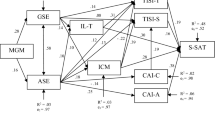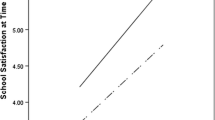Abstract
Objectives
The aim was to explore schoolchildren’s views on how to increase school satisfaction and improve social relations among peers at school.
Method
Improvement suggestions were collected from school children aged 10–12 years with the help of a feedback model developed for the purpose. Qualitative content analysis was used.
Results
Two categories emerged from the analysis: ‘psychosocial climate’, which included the subcategories ‘adults’ roles and responsibilities’ and ‘classmates’ norms and values’; ‘influence’, which included the subcategories ‘changes in the physical environment’ and ‘flexible learning’. The categories are seen as important to increase school satisfaction and improve social relations among peers at school.
Conclusion
Examining children’s opinions is requested and promoted by the UN convention on the Rights of the Child. The findings contribute to the field by showing how school satisfaction and social relations might be improved, if the child perspective is considered in the planning of health promotion activities in school.



Similar content being viewed by others
References
Backman Y, Alerby E, Bergmark U et al (2012) Learning within and beyond the classroom: compulsory school students voicing their positive experiences of school. Scand J Educ Res 56:555–570. doi:10.1080/00313831.2013.821090
Bagot KL, Allen FCL, Toukhsat S (2015) Perceived restorativeness of children’s school playground environments: nature, playground features and play period experiences. J Environ Psychol 41:1–9. doi:10.1016/j.jenvp.2014.11.005
Baker JA (1998) The social context of school satisfaction among urban, low-income, African–American students. Sch Psychol Q 13:25–44. doi:10.1037/h0088970
Bälter O, Fondell E, Bälter K (2012) Feedback in web-based questionnaires as incentive to increase compliance in studies on lifestyle factors. Public Health Nutr 15:982–988. doi:10.1017/S1368980011003041
Beckman L, Hagquist C, Hellström L (2012) Does the association with psychosomatic health problems differ between cyber bullying and traditional bullying? Emot Behav Diffic 17:421–434. doi:10.1016/j.jadohealth.2014.06.007
Bond L, Butler H, Thomas L, Carlin J, Glover S, Bowes G, Patton G (2007) Social and school connectedness in early secondary school as predictors of late teenage substance use, mental health and academic outcomes. J Adolesc Health 357:e9–e18. doi:10.1016/j.jadohealth.2006.10.013
De Giuli V, Da Pos O, De Carli M (2012) Indoor environmental quality and pupil perception in Italian primary schools. Build Environ 56:335–345. doi:10.1016/j.buildenv.2012.03.024
Ediger M (2009) Technical education, the work place, and the student. Am Tech Educ J 36:18–19
Folkhälsomyndigheten (2014) Projektmanual till deltagare i det nationella tillsynsprojektet om inomhusmiljön i skolan. (Project Manual for participants in the national enforcement project on the indoor environment in the school). Östersund: Folkhälsomyndigheten (The Swedish Institute of public health), pp 1–16
General Assembly (1989) The United Nations convention on the rights of the child. Resolution 44/25 of November 1989, pp 164–165
Gorard S, Huat See B (2011) How can we enhance enjoyment of secondary school? The student view. Br Educ Res J 37:671–690. doi:10.1080/01411926.2010.488718
Graneheim UH, Lundman B (2004) Qualitative content analysis in nursing research: concepts, procedures and measures to achieve trustworthiness. Nurse Educ Today 24:105–112. doi:10.1016/j.nedt.2003.10.001
Griebler U, Rojatz D, Simovska V, Forster R (2014) Effects of student participation in school health promotion: a systematic review. Health Promot Int. doi:10.1093/heapro/dat090
Gustafsson E, Allodi Westling M, Alin Åkerman B, Eriksson C, Eriksson L, Fischbein S et al (2010) School, learning and mental health: A systematic review. The Royal Swedish Academy of Science, Stockholm
Hagquist C (2012) Skolmiljö, mobbning och hälsa—Resultat från Ung i Värmland 1988–2011. (School environment, bullying and health—youth survey in Värmland 1988–2011). Karlstad University Press, Karlstad, pp 1–127
Haraldsson K, Lindgren EC, Hildingh C, Marklund B (2010) What makes the everyday life of Swedish adolescent girls less stressful: a qualitative analysis. Health Promot Int 25:192–199. doi:10.1093/heapro/dap061
HBSC (Health behaviour in school-aged children) (2014) Skolbarns hälsovanor 2013/2014. (School children’s health habits 2013/2014 in Sweden). Östersund: Folkhälsomyndigheten (The Swedish Institute of public health), pp 1–112
Hills A, Dengel D, Lubans D (2015) Supporting public health priorities: recommendations for physical education and physical activity promotion in schools. Progr Cardiovasc Dis 57:368–374. doi:10.1016/j.pcad.2014.09.010
Hsieh HF, Shannon SE (2005) Three approaches to qualitative content analysis. Qual Health Res 15:1277–1288. doi:10.1177/1049732305276687
Hui EKP, Sun RCF (2010) Chinese children’s perceived school satisfaction: the role of contextual and intrapersonal factors. Educ Psychol 30:155–172. doi:10.1080/01443410903494452
Jensen BB, Simovska V (2005) Involving students in learning and health promotion processes—clarifying why? what? and how? Promot Educ 12:150–156. doi:10.1177/10253823050120030114
Karlstads kommun (2012) Slutrapport 2012-03-31. Lokalt och sektoröverskridande hälsofrämjande arbete för barn och unga—“50-miljonersprojeket”. (Local and intersectional health promotion for children and young people: “The 50-million project”). Karlstad: Karlstads kommun, Barn- och ungdomsförvaltningen. (Karlstad municipality, Children and youth services), pp 1–32
Leurs M, Schaalma H, Jansen M, Mur-Veeman I, St. Leger L, De Vries N (2005) Development of a collaborative model to improve school health promotion in the Netherlands. Health Promot Int 20:296–301. doi:10.1093/heapro/dai004
Mager U, Nowak P (2012) Effects of student participation in decision making at school. A systematic review and synthesis of empirical research. Educ Res Rev 7:38–61. doi:10.1016/j.edurev.2011.11.001
Markham WA, Aveyard P (2003) A new theory of health promoting schools based on human functioning, school organization and pedagogic practice. Soc Sci Med 56:1209–1220. doi:10.1016/S0277-9536(02)00120-X
Milkie MA, Warner CH (2011) Classroom learning environments and the mental health of first grade children. J Health Soc Behav 52:4–22. doi:10.1177/0022146510394952
Novick MR, Isaacs J (2010) Telling is compelling: the impact of student reports of bullying on teacher intervention. Educ Psychol 30:283–296. doi:10.1080/01443410903573123
Persson L, Haraldsson K (2013) Health promotion in Swedish schools: school managers’ views. Health Promot Int. doi:10.1093/heapro/dta073
PISA (2012) Rustad att möta framtiden? PISA 2012. Om 15-åringars läsförståelse, kunskaper i matematik och naturvetenskap. (Equipped to meet the future? PISA 2012. On 15 year olds’ reading skills and knowledge of mathematics and the natural sciences). Stockholm: Skolverket. (The Swedish National Agency for Education). 2012/394, pp 1–152
Rowe F, Stewart D (2011) Promoting connectedness through whole-school approaches- key elements and pathways of influence. J Health Educ 111:49–65. doi:10.1108/09654281111094973
Sansolios S, Egberg Mikkelsen B (2011) Views of parents, teachers and children on health promotion in kindergarten-first results from formative focus groups and observations. Int J Pediatr Obes 6:28–32. doi:10.3109/17477166.2011.613659
Schwebel DC (2006) Safety on the Playground: mechanisms through which adult supervision might prevent child playground injury. J Clin Psychol Med Settings 13:141–149. doi:10.1007/s10880-006-9018
Skolverket (2013) Attityder till skolan 2012. (Attitudes to school 2012). Stockholm: Skolverket. (The Swedish National Agency for Education), pp 1–148
Srabstein JC, Leventhal BL (2010) Prevention of bullying-related morbidity and mortality: a call for public health policies. Bull World Health Organ 88:403. doi:10.2471/BLT.10.077123
Sveriges Regering (2007/08) En förnyad folkhälsopolitik. Regeringens proposition (A New Public Health Policy. Government bill). Stockholm: Sveriges Regering (The Swedish Government). 2007/08:110, pp 1–122
Sveriges Riksdag (2010/800) Skollagen (The Education Act) (The Swedish Parliament). 2010:800
Vitaro F, Larocque D, Janosz M, Tremblay RE (2001) Negative social experiences and dropping out of school. Educ Psychol 21:401–415. doi:10.1080/01443410120090795
Waters SK, Cross DS, Runions K (2009) Social and ecological structures supporting adolescent connectedness to school: a theoretical model. J Sch Health 79:517–524. doi:10.1111/j.1746-1561.2009.00443.x
Whitlock JL (2006) Youth perceptions of life at school: contextual correlates of school connectedness in adolescence. Appl Dev Sci 10:13–29. doi:10.1207/s1532480xads1001_2
World Health Organization (1986) The Ottawa Charter for health promotion. WHO Regional Office for Europe, Copenhagen
World Health Organization (2000) Local action—creating health-promoting schools. WHO Regional Office for Europe, Copenhagen
Xu J (2012) Predicting students’ homework environment management at the secondary school level. Educ Psychol 32:183–200. doi:10.1080/01443410.2011.635639
Acknowledgments
This work was financially supported by the Swedish National Institute of Public Health and formalized as an agreement between Karlstad University and the City of Karlstad.
Author information
Authors and Affiliations
Corresponding author
Rights and permissions
About this article
Cite this article
Persson, L., Haraldsson, K. & Hagquist, C. School satisfaction and social relations: Swedish schoolchildren’s improvement suggestions. Int J Public Health 61, 83–90 (2016). https://doi.org/10.1007/s00038-015-0696-5
Received:
Revised:
Accepted:
Published:
Issue Date:
DOI: https://doi.org/10.1007/s00038-015-0696-5




